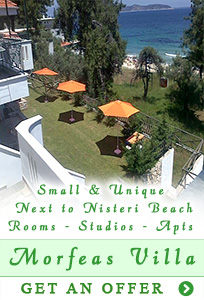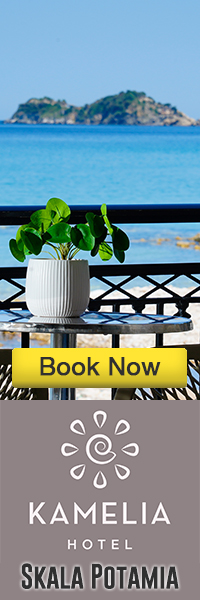Limenaria












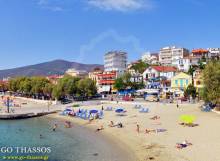
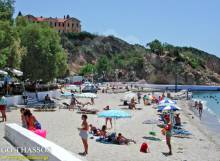
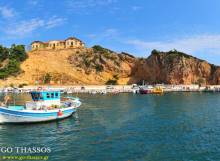
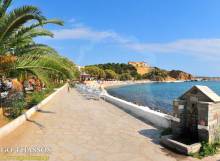
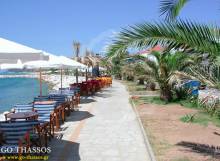
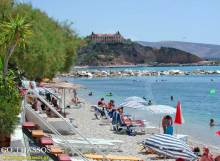
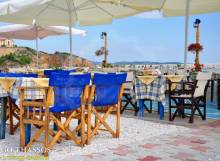
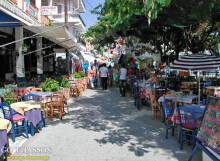
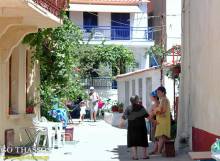
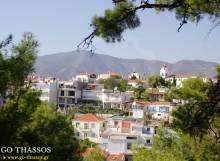
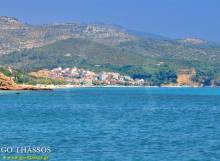
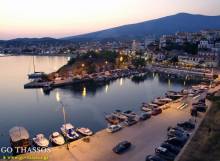
Limenaria
This lovely village is located on the island's south-west coast and forms a community together with the neighbouring settlement of Kalivia. Limenaria has a beautiful harbour and offers absolutely gorgeous views of the Aegean Sea and the holy mountain, Mount Athos.
Limenaria is in an area which has one of the mildest climates on the island, and it has become a very popular destination for holidaymakers. It has retained its unique local culture and many Greek traditions. Visitors can enjoy a wide choice of tavernas and restaurant, serving local Greek dishes, and many of these restaurants are located adjacent to the sea, all along the coastline of the town. There are also to be found numerous cafés, bars, shops and kiosks all providing a very wide range of necessities and souvenirs. All of the facilities are within walking distance, and it is a very pleasant environment to walk around, and absorb the simplicity of this way of life which hasn't changed for many, many years.
There is however plenty to do in the town. There are beautiful beaches up and down the entire stretch of its coastline, and even within the town itself there is a sandy beach. One barely has to walk far from the beach for a snack or a meal in the adjacent restaurants and sandwich shops.
Read MoreA little west of Limenaria, there is a very long beach, about 2 km in length, which slopes gently into the sea. Immediately afterwards there is the beautiful and renowned Trypiti Beach.
If you travel to the east of Limenaria you will immdiately find Metalia Beach, an enchanting and picturesque stretch of sand and pebbles in a fabulously beautiful location. Also, in this area one can explore the remains of the mines if one wishes to acquaint oneself with the history of the area.
About 2 1/2 kilometres further along the coastal road, one can find Pefkari Beach, named after the pine trees which surround it, with its absolutely beautiful sandy and pebbly beach.
A little way beyond this as well, there is the village of Potos, only about 4 kms from Limenaria. It is very much an environment for young and energetic people, providing an exciting and vibrant atmosphere for a fun night out as well as a beautiful sandy beach.
Further still, and the road is so good it will be no difficulty for anybody to explore either by car, bus, motorcycle or bike, one can find Rossogremos Beach (carved into the pink rock) the fabulous wide and sandy beach which every visitor to the island must spend some time at, and after that the deservedly renowned beach of Psili Ammos - “fine sand”.
As you can see, Limenaria should not be overlooked when visiting Thassos. It has so much to offer plus endless possibilities for fun and entertainment in the surrounding areas.
Limenaria has a very interesting history, although it only really began at the start of the 20th century when the mining of the minerals in the area was commenced by the German company Speidel. This mining began in 1905 and continued up until 1912. The local mines were rich in reserves of cadmium and zinc. After the war, mining recommenced from 1925 onwards, by an Italian company known as Vielle Montagne, right up to 1930, and they installed new machinery to extract the minerals, building mining engines with combustion mechanisms and chimneys, the remains of which can still be seen today.
The head office of the Spiedel Mineral Company was built right on top of the prominent cliff on the east of Limenaria. It dominates the town, and is certainly worth a visit. It is called the Palataki, the little palace, and beneath it, there is an old mine that can also be explored. Nearby there is a Folklore Museum with many local finds and offering a variety of musical and theatrical events in the summer.
As the mining industry here grew, it provided a good income and a good quality of life for the workers. The population of this area grew rapidly and peaked during the early 20th century for several reasons. Firstly, residents of the mountain village of Kastro, where there had been little well-paid work, and which had been somewhat distant from the modernisation of other towns on the island, came to Limenaria to work in these local industries.
At the same time, the Treaty of Lausanne led to the exchange of populations between Greece and Turkey. Many Greek refugees from Asia Minor who had been forced to abandon their houses in Turkey, so came back to Greece by ship and landed in the harbour of Limenaria. These refugees brought with them their culture, their different ideas, different ideologies and gave new life to this thriving community. Many of them settled in the area just north of Limenaria and built their modest homes there. This settlement became known as Kalivia, which means 'the village of huts'.







